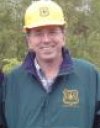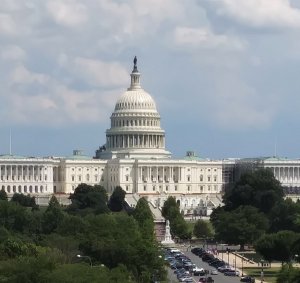
David N. Bengston
Submitted by David N. Bengston on

U.S. Capitol dome. Photo by C. G. Wagner
I’ve traveled to Washington, D.C., many times in my career with the Research and Development branch of the U.S. Forest Service. Most trips were to meet with folks in the Washington office of the agency or to give a seminar on a research project.
A recent trip was different. On September 15, I participated in a Congressional Briefing organized by the Association of Ecological Research Centers (AERC). The AERC holds annual briefings on Capitol Hill about timely topics related to the policy relevance of ecosystem research.
This was a first for me. My typical modus operandi is giving presentations at research conferences and meetings of forest managers and stakeholders. But a congressional briefing? On Capitol Hill? That sounded scary. My anxiety subsided when I found out the audience would be legislative staffers and not members of Congress!
The topic of this year’s AERC briefing was “The Role of Horizon Scanning in Ecosystem Research.” The organizers had seen publications related to the US Forest Service’s ongoing Forest Futures Horizon Scanning project and invited me to participate.
Horizon scanning is a core tool in futures research, so it seems obvious—even obligatory—to include a futurist in a briefing on this topic. But most horizon scanning is carried out by practitioners in other fields and disciplines. The best-known horizon scan related to the natural environment is the work of conservation biologist William Sutherland at the University of Cambridge. Sutherland and colleagues have published annual horizon scans of global conservation issues for 13 consecutive years. Given all the outstanding horizon scanning done by non-futurists, I felt fortunate to be included as the lone futurist.
The other speakers at this year’s briefing included Dr. Jonathan Kolby of the Smithsonian’s National Zoo and Conservation Biology Institute. His presentation was an introduction to horizon scanning as a strategic tool in environmental planning. Dr. Lucinda Johnson, director of research at the Natural Resources Research Institute, University of Minnesota–Duluth, talked about a horizon scanning case study focused on the Laurentian Great Lakes.
My presentation was focused on the Forest Futures Horizon Scanning project, with examples of significant emerging issues it has uncovered, like growing indigenous empowerment and lab-grown wood. I also described our use of the futures wheel to explore possible direct and indirect consequences of emerging issues.
On the morning of the briefing, the three speakers and several AERC organizers met in the hotel lobby and walked to the Rayburn House Office Building. We ran the gauntlet of security screening, were escorted to the briefing room, and quickly set up. This was a hybrid event, with some audience members in the room but most attending virtually. Other than a late start due to long security lines, the briefing went off without a hitch. The audience of young, smart congressional staffers seemed interested and engaged. They asked good questions.
I came away with a greater appreciation of what goes into science policy at the national level, a deeper respect for the highly competent professionals who work on Capitol Hill, and a renewed belief in the value of foresight to inform planning and policy making. Audience members gained an understanding of what horizon scanning is and how it can generate timely foresight.
I may not have been the first futurist to participate in a congressional briefing of this type, but it was a first for me—and definitely a career highlight!
References
David N. Bengston, 2013. Horizon Scanning for Environmental Foresight: A Review of Issues and Approaches. Gen. Tech. Rep. NRS-121. Newtown Square, PA: U.S. Department of Agriculture, Forest Service, Northern Research Station. 20 p. https://www.fs.usda.gov/treesearch/pubs/44822
David N. Bengston, 2015. “The futures wheel: a method for exploring the implications of social-ecological change.” Society & Natural Resources. 29(3): 374-379. https://www.fs.usda.gov/treesearch/pubs/50218
David N. Bengston, 2021. “Lab-grown wood: a potential game changer for forestry and forest products.” The Forestry Source. 26(3): 10, 17. https://www.fs.usda.gov/treesearch/pubs/62554
Michael J. Dockry, 2020. “Indigenous rights and empowerment in natural resource management and decision making as a driver of change in U.S. forestry.” In: Michael J. Dockry, David N. Bengston, Lynne M. Westphal, comps. Drivers of Change in U.S. Forests and Forestry Over the Next 20 Years. Gen. Tech. Rep. NRS-P-197. Madison, WI: U.S. Department of Agriculture, Forest Service, Northern Research Station: 76–83. https://doi.org/10.2737/NRS-GTR-P-197-paper8
Andy Hines, David N. Bengston, and Michael J. Dockry, comps. 2019. The Forest Futures Horizon Scanning Project. Gen. Tech. Rep. NRS-P-187. Newtown Square, PA: U.S. Department of Agriculture, Forest Service, Northern Research Station. 81 p. https://doi.org/10.2737/NRS-GTR-P-187 URL: https://www.fs.usda.gov/treesearch/pubs/57939
William J. Sutherland et al. 2022. “A horizon scan of global biological conservation issues for 2022.” Trends in Ecology & Evolution 37(1): 95-104. https://doi.org/10.1016/j.tree.2021.10.014 URL: https://www.sciencedirect.com/science/article/pii/S0169534721002895
About the Author
David N. Bengston is an environmental futurist with the Strategic Foresight Group, Northern Research Station, USDA Forest Service. He may be contacted at david.bengston@usda.gov.
